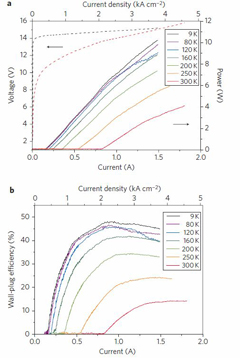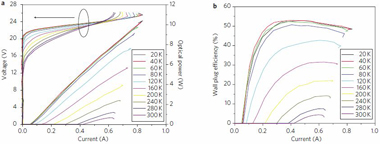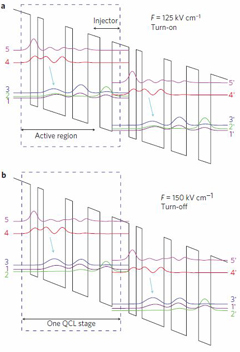
| Home | About Us | Contribute | Bookstore | Advertising | Subscribe for Free NOW! |
| News Archive | Features | Events | Recruitment | Directory |
News
11 January 2010
Producing more light than heat from quantum cascade lasers
Two separate groups have reported increased wall-plug efficiency (WPE) for quantum cascade lasers (QCLs) in Nature Photonics [online 10 January 2010, Peter Q. Liu et al; Yanbo Bai et al].
 Figure 1: Pulsed light–current–voltage measurements (a) and extracted WPE (b) for Princeton/John Hopkins/AdTech QCL.
Figure 1: Pulsed light–current–voltage measurements (a) and extracted WPE (b) for Princeton/John Hopkins/AdTech QCL.
One group (Peter Q. Liu et al) involves scientists from Princeton and John Hopkins universities, along with researchers at QCL specialty company AdTech Optics Inc of City of Industry, CA, USA. This group has designed and implemented an ‘ultrastrong coupling’ strategy to achieve WPEs of 40–50% when operated in pulse-mode at temperatures less than 160K (Figure 1). The ultrastrong coupling aims to achieve efficient transport of electrons into the active regions of the QCL. Normally, this is limited by the interface-roughness-induced detuning of resonant tunneling.
The other research group (Yanbo Bai et al) comes from the Center for Quantum Devices at Northwestern University. This team uses a single-well injector to achieve 53% WPE (Figure 2) at 40K (Figure 3) with an emitting wavelength of 5μm. “In other words, we demonstrate a quantum cascade laser that produces more light than heat.”

Figure 2: Pulsed light–current–voltage measurements (a) and extracted WPE (b) for Northwestern QCL.
QCLs use thousands of layers of wells and barriers to create sub-bands in a cascade of stages consisting of successive injector and active regions. The injection uses resonant tunneling. Both groups used InGaAs wells and InAlAs barriers. Electron transitions between the sub-bands result in the emission of photons.
Although internal quantum efficiencies can reach 80% at low temperature, WPEs up to now have been limited to around 35% or less, excluding cooling requirements (such as the energy needed to produce liquid helium or nitrogen for cryogenic work).
QCL frequencies can range from terahertz to the mid-infrared (350–2.7μm wavelengths). Mid-infrared QCLs could be used as light sources for molecular detection for environmental or medical monitoring.
The Princeton/John Hopkins/AdTech group based their work on recent theoretical calculations by some of the team suggesting that interface-roughness-induced detuning of the resonant tunneling is a more important limiting factor for electron transport and gain in QCLs than broadening of the radiative transition that had previously been blamed for poor performance. To overcome the poor coupling, the researchers used much thinner injection barriers (~10Å, rather than 30-40Å). This gave a coupling strength of ~10meV as opposed to 2–4meV for traditional designs.
The QCLs were grown on indium phosphide (InP) substrates using metal-organic chemical vapor deposition (MOCVD) and strain-balanced layers of In0.66Ga0.34As/Al0.69In0.31As well/barriers. Ridge waveguides were constructed of width 13.5-21.5μm.
The wavelength of the laser radiation was ~4.5μm at 80K and ~4.7μm at room temperature (300K). The characteristic temperature for the slope efficiency (T1) was 330K, much better than the usual values of less than 300K. The threshold, however, had a poor characteristic temperature (T0) of ~125K. This was blamed on the low two-LO-phonon voltage defect used in the injector design, favoring low-temperature operation and limiting performance at higher temperatures.
Continuous wave (CW) operation showed maximum WPE values of about 30% and output power of 4.5–6W at temperatures less than 80K. The reduced performance is due to the lack of an efficient heat removal and packaging design for CW operation.
 Northwestern has also concentrated on the injector regions for improving QCL performance at low temperature. The researchers point out that many of the features of long injector designs are there to enable higher-temperature operation. Such injectors have to cope with effects such as thermal back-filling that are not a problem at cryogenic temperatures (i.e. less than 80K). Northwestern’s QCLs are designed for low-temperature/high-efficiency operation and use a single-well injector (Figure 3).
Northwestern has also concentrated on the injector regions for improving QCL performance at low temperature. The researchers point out that many of the features of long injector designs are there to enable higher-temperature operation. Such injectors have to cope with effects such as thermal back-filling that are not a problem at cryogenic temperatures (i.e. less than 80K). Northwestern’s QCLs are designed for low-temperature/high-efficiency operation and use a single-well injector (Figure 3).
Figure 3: Conduction band and wavefunction diagram for Northwestern’s single-well injector design with simulations carried out at turn-on (a) and turn-off (b). The wells and barriers consisted of In0.66Ga0.34As and Al0.64In0.36As, respectively.
Another design move is to use only three wells (single phonon resonance) rather than the more usual four wells (double phonon resonance) in the active region. This reduces the voltage defect for turn-on and turn-off per stage, reducing operating voltage and hence power consumption. The period of the QCL structure is 22.1nm as opposed to ~50nm used for this wavelength range in devices designed for room-temperature operation.
For the construction of lasers from an 80-stage QCL structure on n-InP substrates, a 6μm buried ridge was used. Since shorter cavities do not much affect the threshold but do have higher slope efficiency, a 2mm rather than a 5mm cavity length (often used for high-temperature operation) was chosen. Testing was carried out with 200ns pulses and a duty cycle of 5% (250kHz repetition rate). At 80K, the threshold current density and voltage were 05.kA/cm2 and 0.27V, respectively. The slope efficiency was 0.17W/A. Under temperature variation, the WPE peaks at 53.1% at 40K (Figure 2).
The leader of the Northwestern work, professor Manijeh Razeghi, comments that the low-temperature research started as ‘a side project’ to see how high the efficiency could be pushed. “Theory said that high efficiency was possible, but it just hadn’t been done before.”
The Center for Quantum Devices, of which Razeghi is director, is one of three groups currently funded by the US Defense Advanced Research Program Agency (DARPA) to improve the room-temperature QCL efficiency under the Efficient Mid-Wave Infrared Lasers (EMIL) program. She comments: “Similar to our low-temperature work, we have the highest efficiencies of any group to date (23% pulsed, 18% continuous). This project is ongoing, with the eventual aim to get 50% efficiency at room temperature as well.”
See related items:
Accessing higher THz gain with switched quantum cascade lasers
Magnetic QCL emits 3THz at 225K and 0.68THz at 8K
First room-temperature semiconductor source of coherent terahertz radiation
![]() Search: QCLs
Search: QCLs
Visit: http://dx.doi.org/10.1038/NPHOTON.2009.262
Visit: http://dx.doi.org/10.1038/NPHOTON.2009.263
Visit: www.atoptics.com
The author Mike Cooke is a freelance technology journalist who has worked in the semiconductor and advanced technology sectors since 1997.